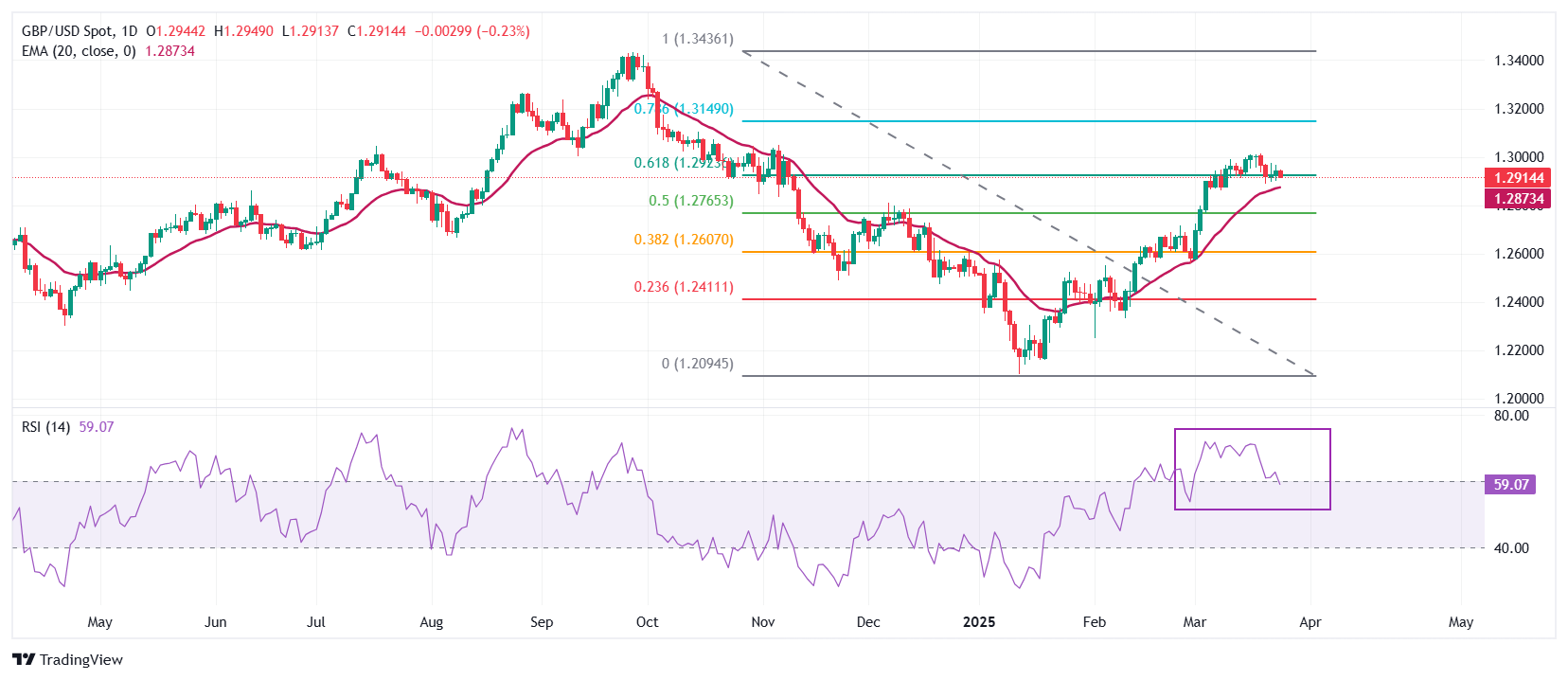- The Pound Sterling falls against its major peers on Wednesday after the release of a cooler-than-expected UK CPI report for February.
- Investors expect UK Chancellor Reeves to announce moderate fiscal spending measures.
- Market participants will pay close attention to the US PCE inflation data on Friday.
The Pound Sterling (GBP) tests region below 1.2900 against the US Dollar (USD) in Wednesday’s European session after the release of the soft United Kingdom (UK) Consumer Price Index (CPI) report for February. The UK CPI report showed that inflation cooled down at a faster-than-expected pace due to a significant slowdown in the prices of clothing and footwear.
Headline CPI increased 2.8% year-over-year (YoY) compared to estimates of 2.9% and the 3.0% increase seen in January. In the same period, the core CPI – which excludes volatile items – rose by 3.5%, against expectations of 3.6% and the former release of 3.7%. Month-on-month headline CPI grew 0.4% after deflating by 0.1% in January, missing estimates of 0.5%.
Inflation in the services sector, which is closely tracked by Bank of England (BoE) officials, rose at a steady pace of 5%. Technically, soft inflation data prompts traders to raise bets supporting the BoE to ease the monetary policy. However, sticky UK service inflation data could limit traders from going all-in for an interest rate cut by the BoE in the May policy meeting.
Meanwhile, the US Dollar stabilizes despite uncertainty over how potential tariffs by President Donald Trump on April 2 will shape the United States (US) economic outlook. The US Dollar Index (DXY), which tracks the Greenback’s value against six major currencies, ticks higher to near 104.40.
Market participants expect that President Trump’s tariff agenda can expose the US economy to a recession, along with a resurgence in inflationary pressures in the near term. On Monday, Trump reiterated threats to unveil tariffs on April 2 but teased that not all impending tariffs will be imposed as he may give a “lot of countries” breaks on tariffs.
Daily digest market movers: Pound Sterling weakens ahead of Spring Statement
- The Pound Sterling faces selling pressure against its major peers on Wednesday. The British currency weakens after the release of the soft UK CPI data for February.
- Meanwhile, investors brace for more volatility in the British currency as UK Chancellor of the Exchequer Rachel Reeves is scheduled to deliver the Spring Statement in the Commons at around 12:30 GMT. Reeves is expected to cut welfare spending as she pledged to avoid tax raises and committed to relying on foreign financing for funding investments only. She is also expected to announce a £2.2bn increase in defence spending amid uncertainty surrounding the Ukraine war, according to BBC News.
- The scenario of lower fiscal spending measures would be unfavorable for the Pound Sterling as lesser government spending results in moderate economic growth, which keeps inflationary pressures capped.
- In the US region, investors seek fresh cues about the Federal Reserve’s (Fed) monetary policy outlook for the remaining year. Regarding this, investors will focus on the US Personal Consumption Expenditures Price Index (PCE) data for February, which will be released on Friday. The US core PCE inflation, the Fed’s preferred inflation gauge, is estimated to have grown 2.7% year-on-year, compared to the 2.6% increase seen in January.
- According to the CME FedWatch tool, the Fed is certain to keep interest rates in the current range of 4.25%-4.50% in the May policy meeting, but there is a 65% chance that interest rates will be lower in June.
Technical Analysis: Pound Sterling declines toward 20-day EMA
The Pound Sterling trades slightly lower to near 1.2900 against the US Dollar on Wednesday. The GBP/USD pair struggles to hold the 61.8% Fibonacci retracement, plotted from the late-September high to mid-January low, at 1.2930.
The 20-day Exponential Moving Average (EMA) near 1.2875 is expected to act as a major support zone for the Pound Sterling bulls.
The 14-day Relative Strength Index (RSI) cools down to near 60.00 after turning overbought above 70.00. Should a fresh bullish momentum come into action if the RSI resumes the upside journey after holding above 60.00.
Looking down, the 50% Fibonacci retracement at 1.2765 and the 38.2% Fibonacci retracement at 1.2610 will act as key support zones for the pair. On the upside, the October 15 high of 1.3100 will act as a key resistance zone.







